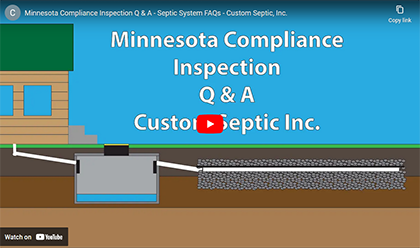Testing Soil Absorption Rate
 Many people may be surprised to learn the amount of Science involved in Treating Sewage Waste. In order to become a Minnesota Licensed Septic Sewer Inspector, individuals go through lots of training to understand the Biological Aspects of breaking down excrement. Soil conditions play a large role in Determining the Best Location to install an On-Site Septic System. Soil Percolation Tests can also be instrumental in deciding on the Septic Design that is best suited for each property. As a MN Licensed Sewer Inspector, Custom Septic, Inc. (CSI) has many hours of training along with about 20 years of experience all around Northern Minnesota and the several Twin City Suburbs.
Many people may be surprised to learn the amount of Science involved in Treating Sewage Waste. In order to become a Minnesota Licensed Septic Sewer Inspector, individuals go through lots of training to understand the Biological Aspects of breaking down excrement. Soil conditions play a large role in Determining the Best Location to install an On-Site Septic System. Soil Percolation Tests can also be instrumental in deciding on the Septic Design that is best suited for each property. As a MN Licensed Sewer Inspector, Custom Septic, Inc. (CSI) has many hours of training along with about 20 years of experience all around Northern Minnesota and the several Twin City Suburbs.
Deciding on Septic Drainfield Location
Soil Percolation Testing is done to see the rate in which the soil will absorb sewer wastewater, also known as Effluent. Someone who has education and experience in Septic System Inspections and Septic Designs should know how to do a Percolation Test on soil. Different types of dirt will react differently when the test is being done. Optimally, soil with a High Sand Content will be best suited for the Sewage Drainfield Soil Absorption area.
Septic System Soil Boring and Testing
The basic procedure of Soil Testing before installing your septic system components can be time consuming and confusing for someone who lacks proper training and experience. Soil Boring Samples will help to guide the Licensed Inspector to figure out where to dig and begin the absorption rate testing. Your MN Septic Inspector or Designer will then be ready to proceed with the necessary steps in the soil testing process.
- Dig at least 3 holes (6” to 8” diameter) as deep as needed for the proposed drain field installation
- Put about 2” of loose gravel into each hole
- Using a hose and funnel, carefully add at least 12” of water
- Leave the water in the hole for anywhere from 4 hours to overnight (clay soil will need at least 12 hours)
- Begin percolation testing
- Water is adjusted to approximately 6” to 8” above the level of the gravel in the bottom of the hole
- Measurements are taken every 30 minutes or as needed to get an accurate rate of absorption
- Percolation rates are figured by dividing the time it takes the water to drop by the measurement in inches (MPI or minutes per inch)
- Readings should be taken until the variation is not more than 10%
- MPI calculations are used to design the drainfield or soil absorption field
MN Licensed Sewer Inspector
Contact Custom Septic Inc. (CSI) for all of your Septic System needs. We provide excellent customer service from a very experienced staff. As the owner and operator of CSI, Brad Krotzer is a MN Licensed Septic Inspector. We are also qualified to do Septic System Designing, Installations and Repairs.
Custom Septic Inc. (CSI) would love to here from You! Give us a call for a Free Estimate at: 763-218-4769

 Now Accepting Major Credit Cards!
Now Accepting Major Credit Cards!
